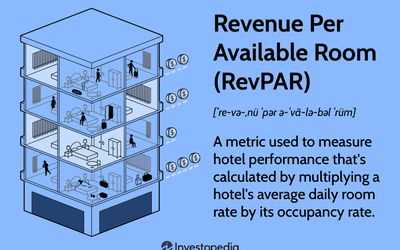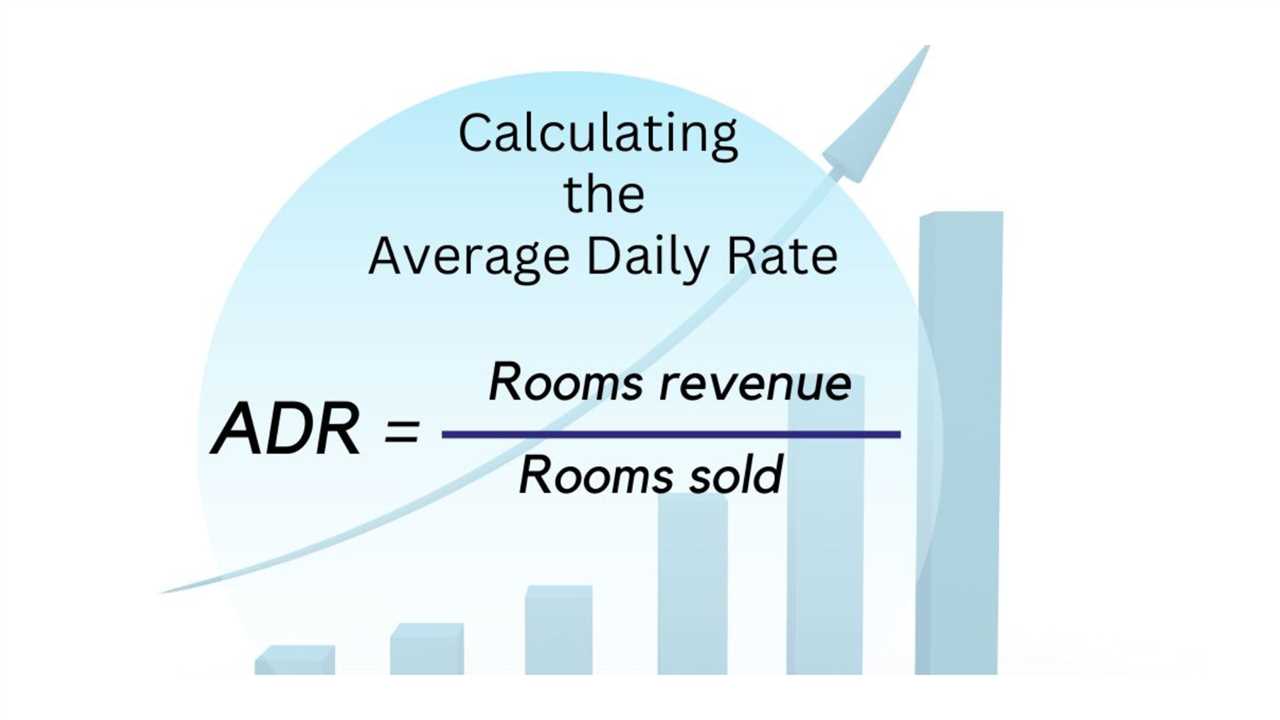How to Calculate Average Daily Rate (ADR)
Calculating the Average Daily Rate (ADR) is an important metric in the hospitality industry. It helps hotel owners and managers understand the average price at which their rooms are being sold on a daily basis. ADR is calculated by dividing the total revenue generated from room sales by the number of rooms sold.
Step 1: Determine the Total Revenue
The first step in calculating ADR is to determine the total revenue generated from room sales. This includes the revenue from all occupied rooms, as well as any additional charges such as room service or amenities. The total revenue can be obtained from the hotel’s financial records or accounting system.
Step 2: Determine the Number of Rooms Sold
The next step is to determine the number of rooms sold during a specific period of time. This can be obtained from the hotel’s reservation system or occupancy reports. It is important to include only the rooms that were actually sold and exclude any complimentary or out-of-order rooms.
Step 3: Divide the Total Revenue by the Number of Rooms Sold

Once the total revenue and number of rooms sold have been determined, divide the total revenue by the number of rooms sold to calculate the Average Daily Rate (ADR). The formula for calculating ADR is:
ADR = Total Revenue / Number of Rooms Sold
For example, if the total revenue generated from room sales is $10,000 and the number of rooms sold is 100, the ADR would be:
ADR = $10,000 / 100 = $100
This means that, on average, each room was sold for $100 per day.
Calculating ADR on a regular basis can help hotel owners and managers track the performance of their pricing strategies and make informed decisions to maximize revenue. It can also be used to compare the hotel’s performance with industry benchmarks and competitors.
What is Average Daily Rate (ADR)?
The Average Daily Rate (ADR) is a key performance indicator used in the hospitality industry to measure the average rate at which hotel rooms are sold over a specific period of time. It is calculated by dividing the total revenue generated from room sales by the number of rooms sold.
The ADR provides valuable insights into a hotel’s pricing strategy and revenue management. It helps hoteliers understand the average price guests are willing to pay for a room, and allows them to adjust their rates accordingly to maximize revenue.
The ADR is typically calculated on a daily basis, but it can also be calculated on a weekly, monthly, or yearly basis depending on the reporting requirements of the hotel. It is often used in conjunction with other performance metrics such as occupancy rate and revenue per available room (RevPAR) to evaluate the overall financial performance of a hotel.
For example, if a hotel generates $10,000 in room revenue over a period of 10 days and sells a total of 100 rooms during that time, the ADR would be calculated as follows:
ADR = Total Room Revenue / Number of Rooms Sold
= $10,000 / 100
= $100
The ADR is an important metric for hoteliers as it directly impacts a hotel’s revenue and profitability. By monitoring and analyzing ADR trends, hoteliers can make informed decisions about pricing, marketing, and sales strategies to attract more guests and increase revenue.
How to Calculate Average Daily Rate (ADR)
The Average Daily Rate (ADR) is a key metric used in the hospitality industry to measure the average revenue generated per available room per day. It is a crucial indicator of a hotel’s performance and profitability.
Formula for Calculating ADR
The formula for calculating ADR is:
ADR = Total Room Revenue / Number of Available Rooms
To calculate the ADR, you need to know the total room revenue generated during a specific period and the number of available rooms during that same period.
Step-by-Step Calculation
Here are the steps to calculate the ADR:
- Determine the total room revenue: Add up the revenue generated from all room bookings during the specific period you want to analyze. This includes revenue from room rates, additional services, and any other charges related to room bookings.
- Count the number of available rooms: Determine the total number of rooms available for booking during the same period. This includes all occupied rooms and any rooms that were out of service for maintenance or other reasons.
- Divide the total room revenue by the number of available rooms: Use the formula mentioned earlier to divide the total room revenue by the number of available rooms. This will give you the ADR.
Example Calculation
Let’s say a hotel generated a total room revenue of $100,000 during a month, and it had 100 rooms available for booking during that same month. The ADR would be calculated as follows:
ADR = $100,000 / 100 = $1,000
Therefore, the Average Daily Rate (ADR) for that month would be $1,000.
By calculating the ADR, hotel managers and owners can assess the effectiveness of their pricing strategies, identify trends, and make informed decisions to optimize revenue and profitability.
Examples of Average Daily Rate (ADR) Calculation
Calculating the Average Daily Rate (ADR) is essential for businesses in the [ACCOUNTING catname] industry as it provides valuable insights into the financial performance of a company. ADR is a key metric used to measure the average revenue generated per available room or unit on a daily basis.
Example 1:
Let’s consider a hotel that has 100 rooms and generates a total revenue of $10,000 in a month. To calculate the ADR, divide the total revenue by the number of available rooms and the number of days in a month:
Total Revenue: $10,000
Number of Available Rooms: 100
Number of Days in a Month: 30
ADR = Total Revenue / (Number of Available Rooms * Number of Days in a Month)
ADR = $10,000 / (100 * 30)
ADR = $10,000 / 3,000
ADR = $3.33
Therefore, the ADR for this hotel is $3.33 per available room per day.
Example 2:

Consider a vacation rental company that manages 50 properties and generates a total revenue of $15,000 in a month. To calculate the ADR, divide the total revenue by the number of available properties and the number of days in a month:
Total Revenue: $15,000
Number of Available Properties: 50
Number of Days in a Month: 30
ADR = Total Revenue / (Number of Available Properties * Number of Days in a Month)
ADR = $15,000 / (50 * 30)
ADR = $15,000 / 1,500
ADR = $10
Therefore, the ADR for this vacation rental company is $10 per available property per day.
Calculating the ADR allows businesses to assess their pricing strategies, identify trends, and make informed decisions to optimize revenue. It is an essential metric for evaluating the financial performance and profitability of companies in the [ACCOUNTING catname] industry.
Importance of Average Daily Rate (ADR) in Accounting
The Average Daily Rate (ADR) is a crucial metric in the field of accounting. It provides valuable insights into the financial performance of a business, specifically in the hospitality industry. ADR is used to calculate the average revenue generated per available room on a daily basis.
1. Performance Measurement:
ADR is an essential tool for measuring the financial performance of hotels, resorts, and other accommodation establishments. By analyzing the ADR, accountants and financial analysts can assess the revenue generation efficiency of the business. It helps in evaluating the success of pricing strategies and identifying areas for improvement.
2. Revenue Management:
ADR plays a vital role in revenue management strategies. By monitoring the ADR, businesses can make informed decisions regarding pricing, promotions, and discounts. It helps in maximizing revenue by optimizing room rates based on demand and market conditions. A higher ADR indicates that the business is effectively managing its pricing strategy and attracting customers willing to pay higher rates.
3. Financial Planning and Budgeting:
ADR is an essential factor in financial planning and budgeting for accommodation establishments. It provides a benchmark for estimating future revenue and forecasting financial performance. By analyzing historical ADR data, businesses can make accurate projections and set realistic revenue targets. It helps in developing effective budgeting strategies and allocating resources efficiently.
4. Competitive Analysis:
ADR is also a valuable metric for competitive analysis. By comparing the ADR of different businesses within the same market or region, accountants can assess the competitiveness of their own establishment. It provides insights into market trends, customer preferences, and pricing strategies of competitors. This information can be used to identify opportunities for growth and stay ahead of the competition.
Conclusion:
Overall, the Average Daily Rate (ADR) is a critical metric in accounting, especially in the hospitality industry. It helps businesses measure performance, optimize revenue, plan finances, and stay competitive. By analyzing and utilizing ADR effectively, businesses can make informed decisions and drive financial success.

Emily Bibb simplifies finance through bestselling books and articles, bridging complex concepts for everyday understanding. Engaging audiences via social media, she shares insights for financial success. Active in seminars and philanthropy, Bibb aims to create a more financially informed society, driven by her passion for empowering others.
